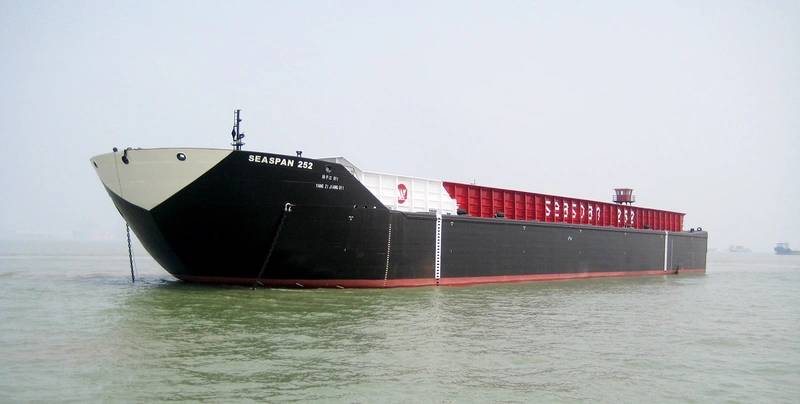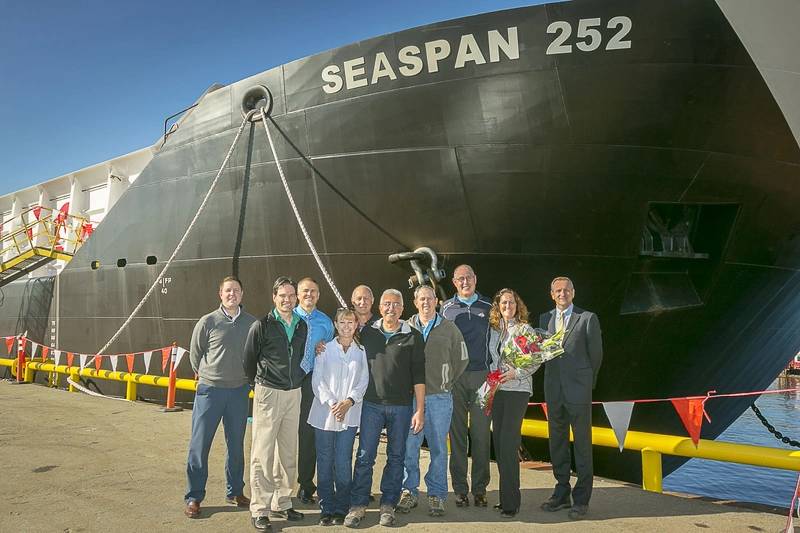Seaspan Unveils Massive Barge in Canada
Seaspan bulks up investment in BC’s marine sector, celebrates addition of fourth new barge in the past 10 months
Seaspan Marine unveiled the newest addition to its marine fleet, a 16,000-metric-ton barge named Seaspan 252, during an official commissioning ceremony at Seaspan’s North Vancouver Barge Maintenance Terminal today.
The 114-meter-long by 27.5-meter-wide bulk barge is the largest of its kind in Canada, and can carry the equivalent of 1,454 standard dump truck loads of limestone.
Designed by Robert Allan Ltd. of Vancouver, B.C. and constructed by Seabridge Marine Contractors Ltd. at Jiangsu Yanzijiang Shipbuilding Co. Ltd. in China, Seaspan 252 was launched on July 31 and handed over to Seaspan in August.
An open ocean, ABS classed + A1 barge, the Seaspan 252 is the company’s fourth new barge over the past 10 months, following the Seaspan 211 and 212 in June, and the Solid 66 in late 2014.
Seaspan CEO, Jonathan Whitworth, said, “Today’s celebration exemplifies our latest investment in the future of British Columbia’s marine sector. With the addition of four large barges to our fleet in less than a year, Seaspan continues to help drive Canada’s marine industrial base, with an unwavering commitment to its people, customers and equipment.”
These new four barges add a total of 44,000 metric tons of barging capacity and an almost 50 percent rise in volume to Seaspan’s fleet. The additional barges increase Seaspan’s ability to handle specialty and project cargo and prepare the company to meet the needs of both its current customers, as well as those in the LNG business.
The Seaspan 252 was commissioned by Linda Peters, wife of Daniel Peters, Vice President – Manufacturing, West for Ash Grove Cement Company.
The barge has a flush deck and raised forecastle. The hull form includes a semi-spoon, seagoing bow, round bilges and a stern rake with sidewall skegs. A three-meter-high steel cargo box surrounds the main deck. The limerock is loaded by a shore-mounted conveyor system. Unloading is accomplished by two large front end loaders which operate on top of the cargo load, feeding a hopper located amidships that in turn feeds a short shuttle conveyor to shore. The conveyor system as well as the deck machinery consisting of an anchor windlass, bridle winch and two mooring capstans, are powered by a 72-kilowatt John Deere EPA Tier III generator installed in a machinery space at the bow.
Primarily intended for towing on a hawser, the barge is fitted with twin skegs aft for directional stability. As this type of skeg can represent 25-30 percent of the total resistance of the barge Computational Fluid Dynamics (CFD) analysis was used by Robert Allan Ltd, to optimize the skegs and reduce their resistance as much as possible, while still maintain the necessary towed directional stability. All of this process is much faster and more cost-effective than traditional model testing, especially the directional stability analysis which is very difficult to do accurately in a small or medium-size laboratory tank, the designer said.
The barge is scheduled to enter service in October for Ash Grove, hauling limerock from Texada Island to Portland, Ore. and Seattle, Wash.


